Complete Solutions to Linked Comprhension type MCQs of chapter STATE OF MATTER (GASEOUS AND LIQUID STATE) of Class 11 book with complete answers and questions
| Class 11 | CHEMISTRY |
| Chapter | STATE OF MATTER (GASEOUS AND LIQUID STATE) |
| DINESH OBJECTIVE CHEMISTRY | Linked Comprhension type MCQs |
| Number Of Questions | 11 |
| Academic Year | 2023-24 |
The van der Waal's equation of state for 1 mole real gas is `(P + (a)/(V^(2))) (v - b) = RT`....(i)
The Virial equation for 1 mole real gas is `PV = RT [1 + (x)/(V) + (y)/(V^(2)) + (z)/(V^(3))+....." To higher power of " V]` ....(ii)
when x, y and z are constants which are known as 2nd, 3rd adn 4th co-efficients respectively. The temperature at which real gas obeys ideal gas equation i.e., `(PV = nRT)` is known as Boyle's temperature.
Answer the following questions on the basis of the above write up :
If equation (ii) can be one of the way of writing of equation (i), then what will be the value of y?
View SolutionThe van der Waal's equation of state for 1 mole real gas is `(P + (a)/(V^(2))) (v - b) = RT`....(i)
The Virial equation for 1 mole real gas is `PV = RT [1 + (x)/(V) + (y)/(V^(2)) + (z)/(V^(3))+....." To higher power of " V]` ....(ii)
when x, y and z are constants which are known as 2nd, 3rd adn 4th co-efficients respectively. The temperature at which real gas obeys ideal gas equation i.e., `(PV = nRT)` is known as Boyle's temperature.
Answer the following questions on the basis of the above write up :
Which of the following is the incorrect statement about the Boyle's temperature ?
View SolutionThe van der Waal's equation of state for 1 mole real gas is `(P + (a)/(V^(2))) (v - b) = RT`....(i)
The Virial equation for 1 mole real gas is `PV = RT [1 + (x)/(V) + (y)/(V^(2)) + (z)/(V^(3))+....." To higher power of " V]` ....(ii)
when x, y and z are constants which are known as 2nd, 3rd adn 4th co-efficients respectively. The temperature at which real gas obeys ideal gas equation i.e., `(PV = nRT)` is known as Boyle's temperature.
Answer the following questions on the basis of the above write up :
The third virial coefficient of He gas is `4 xx 10^(-2)` `("litre/mole")^(2)`, then what will be volume of 2 mole He gas at NTP
View SolutionThe van der Waal's equation of state for 1 mole real gas is `(P + (a)/(V^(2))) (v - b) = RT`....(i)
The Virial equation for 1 mole real gas is `PV = RT [1 + (x)/(V) + (y)/(V^(2)) + (z)/(V^(3))+....." To higher power of " V]` ....(ii)
when x, y and z are constants which are known as 2nd, 3rd adn 4th co-efficients respectively. The temperature at which real gas obeys ideal gas equation i.e., `(PV = nRT)` is known as Boyle's temperature.
Answer the following questions on the basis of the above write up :
If the critical temperature of the gas be
`T_(C) = (8a)/(27 Rb)` and `T_(B)` is the Boyle's temperature, then which of the following is the correct relation between `T_(C) " and " T_(B)`?
View SolutionReal gases deviated from ideal behaviour due to the following two faulty assumptions of kinetic theory of gases :
(i) Actual volume occupied by the gas molecule is negligible as compared to the total volume of the gases
(ii) Forces of attraction and repulsion among gas molecules are negligible
To explain the extent of deviation of the real gas from ideal behaviour in terms of compressibility or compression factor `(z)`, which is the function of pressure and temperature for real gases `z = (P_(0)V_(0))/(nRT)` For ideal gases `z = 1`. for real gases either `z gt 1 " or " z gt 1`.
When `z gt 1`, then it is less compressible because force of repulsion dominates over force of attraction. When `z lt 1`, force of attraction dominates over the repulsion and it is more compressible.
Graph in between z and P is shown below on increasing the temperature, z increases and approaches to unity. Graph between z and p at different temperature are as under
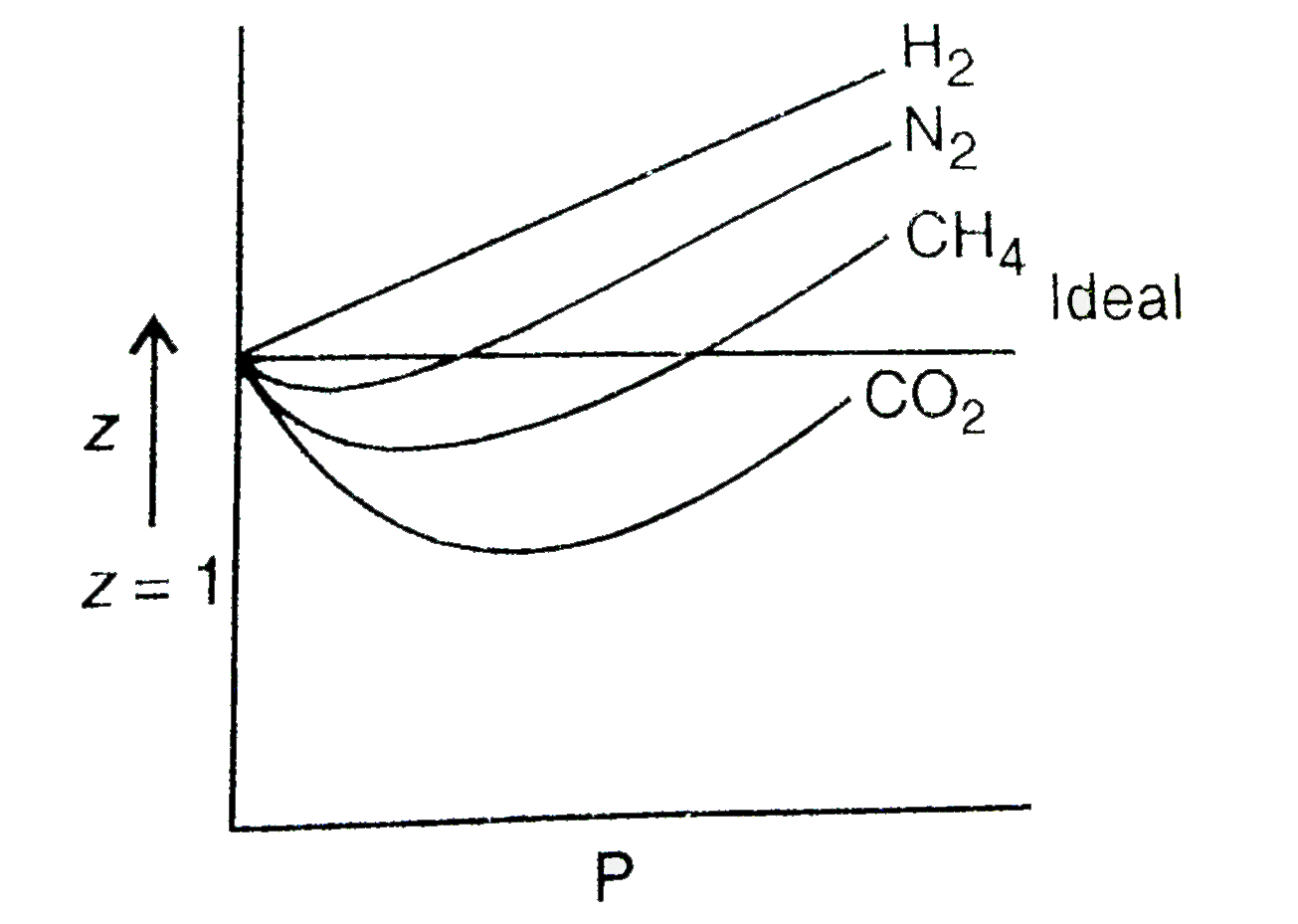

Answer the following questions on the basis of above write up :
What is correct increasing order of liquefibility of the gases shown in the above graph ?
View SolutionReal gases deviated from ideal behaviour due to the following two faulty assumptions of kinetic theory of gases :
(i) Actual volume occupied by the gas molecule is negligible as compared to the total volume of the gases
(ii) Forces of attraction and repulsion among gas molecules are negligible
To explain the extent of deviation of the real gas from ideal behaviour in terms of compressibility or compression factor `(z)`, which is the function of pressure and temperature for real gases `z = (P_(0)V_(0))/(nRT)` For ideal gases `z = 1`. for real gases either `z gt 1 " or " z gt 1`.
When `z gt 1`, then it is less compressible because force of repulsion dominates over force of attraction. When `z lt 1`, force of attraction dominates over the repulsion and it is more compressible.
Graph in between z and P is shown below on increasing the temperature, z increases and approaches to unity. Graph between z and p at different temperature are as under
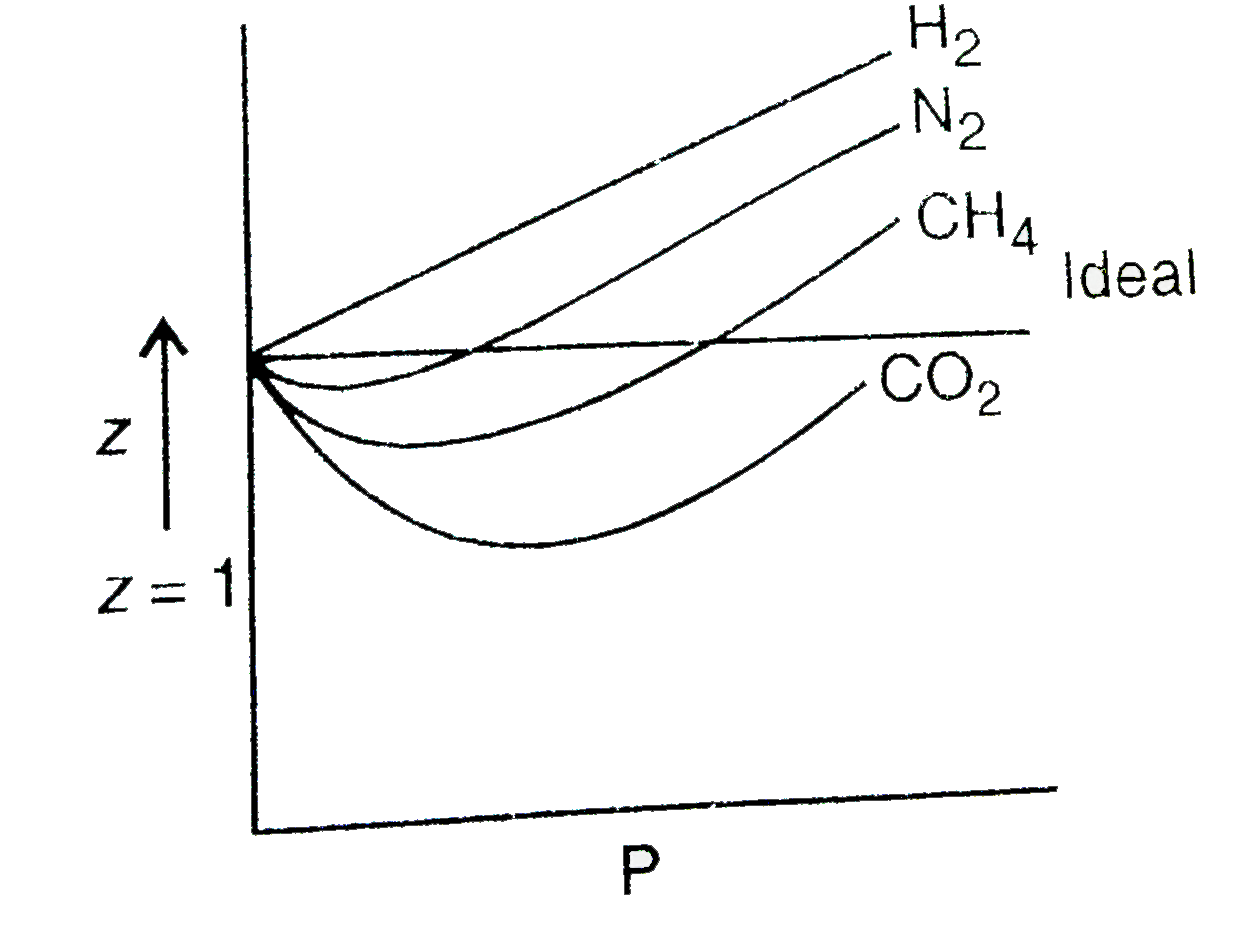
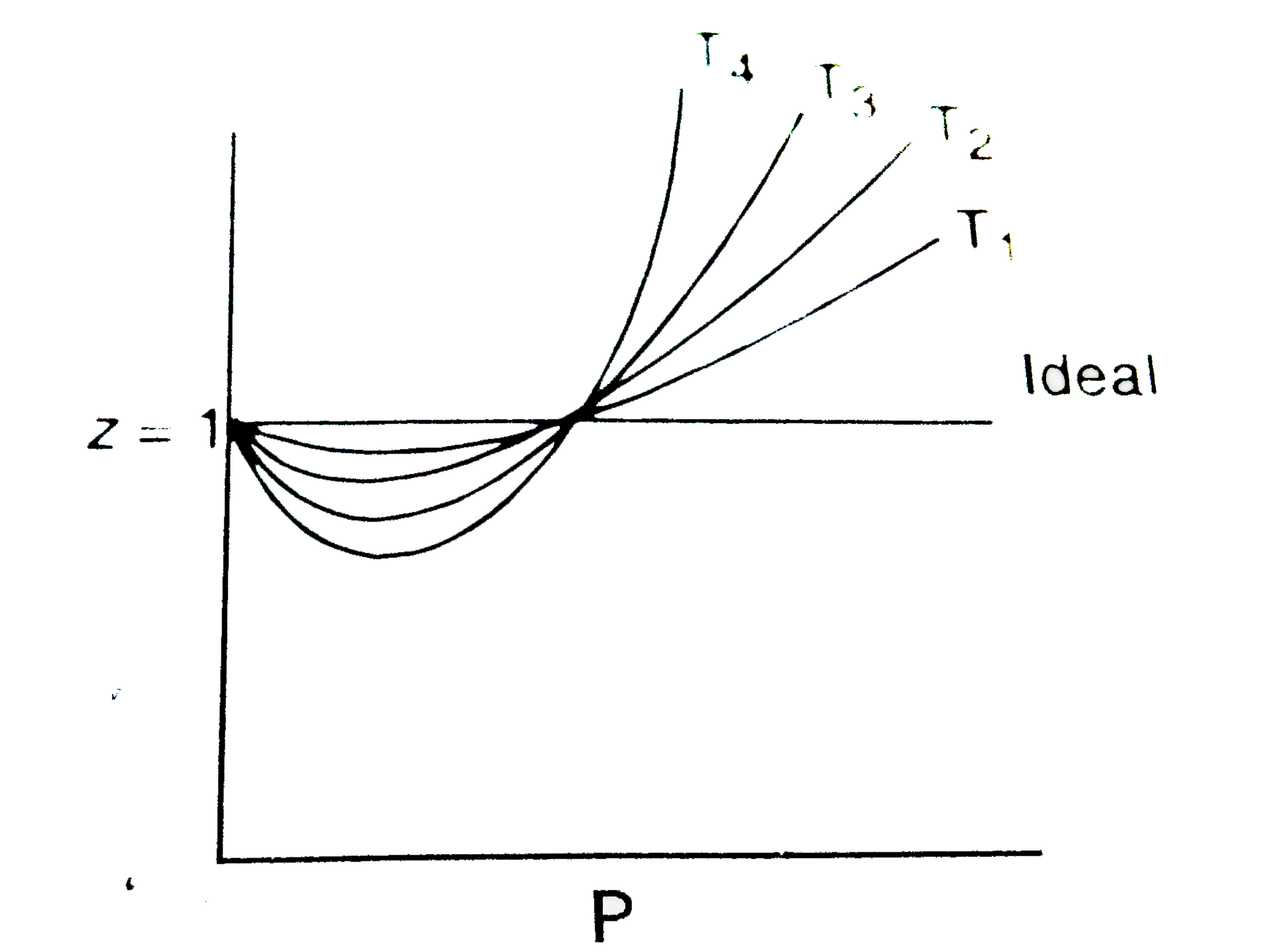
Answer the following questions on the basis of above write up :
Which of the following statements is correct ?
View SolutionReal gases deviated from ideal behaviour due to the following two faulty assumptions of kinetic theory of gases :
(i) Actual volume occupied by the gas molecule is negligible as compared to the total volume of the gases
(ii) Forces of attraction and repulsion among gas molecules are negligible
To explain the extent of deviation of the real gas from ideal behaviour in terms of compressibility or compression factor `(z)`, which is the function of pressure and temperature for real gases `z = (P_(0)V_(0))/(nRT)` For ideal gases `z = 1`. for real gases either `z gt 1 " or " z gt 1`.
When `z gt 1`, then it is less compressible because force of repulsion dominates over force of attraction. When `z lt 1`, force of attraction dominates over the repulsion and it is more compressible.
Graph in between z and P is shown below on increasing the temperature, z increases and approaches to unity. Graph between z and p at different temperature are as under

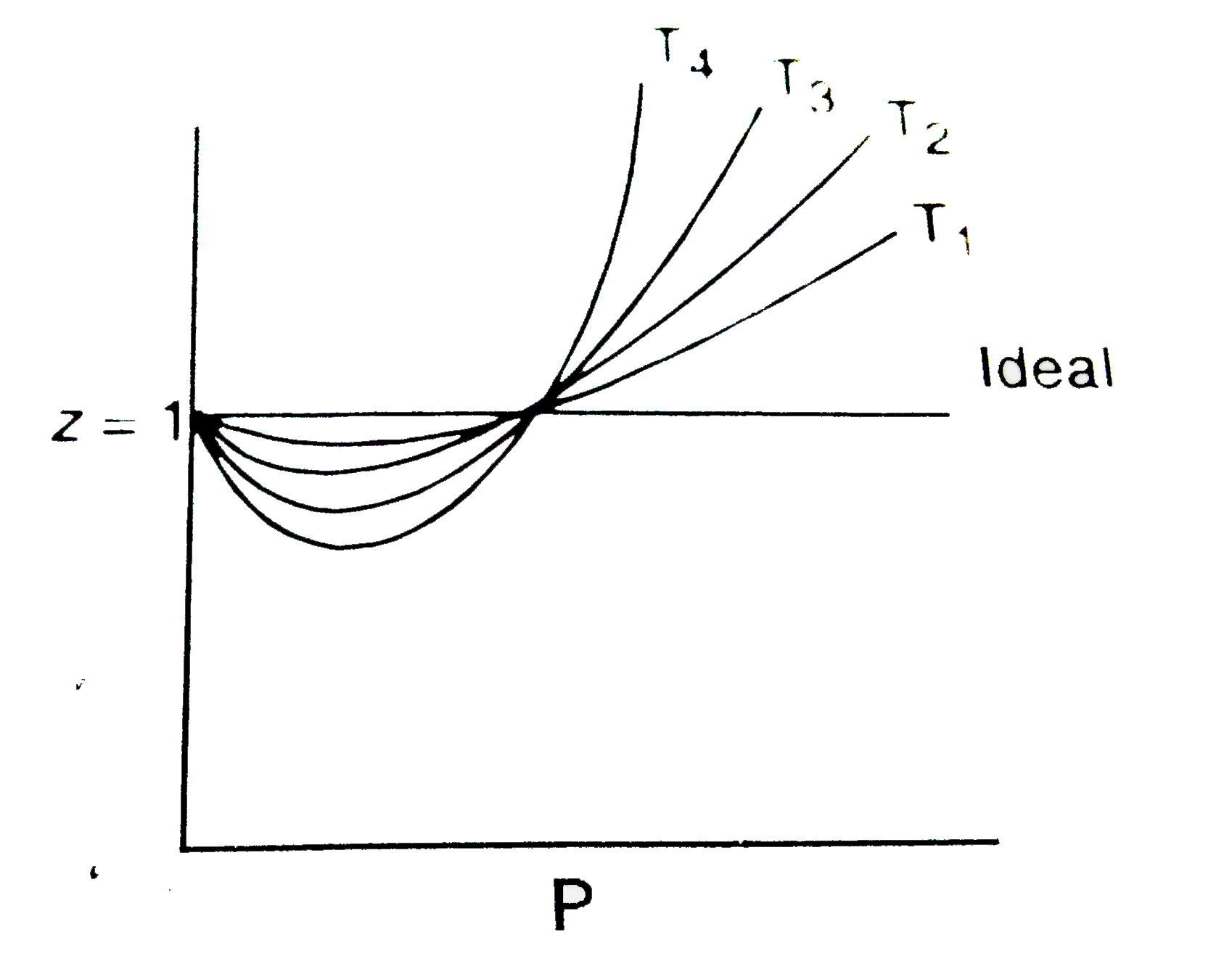
Answer the following questions on the basis of above write up :
Which of the following is the correct order of temperature shown in the above graph `z` vs P for the same gas
View SolutionReal gases deviated from ideal behaviour due to the following two faulty assumptions of kinetic theory of gases :
(i) Actual volume occupied by the gas molecule is negligible as compared to the total volume of the gases
(ii) Forces of attraction and repulsion among gas molecules are negligible
To explain the extent of deviation of the real gas from ideal behaviour in terms of compressibility or compression factor `(z)`, which is the function of pressure and temperature for real gases `z = (P_(0)V_(0))/(nRT)` For ideal gases `z = 1`. for real gases either `z gt 1 " or " z gt 1`.
When `z gt 1`, then it is less compressible because force of repulsion dominates over force of attraction. When `z lt 1`, force of attraction dominates over the repulsion and it is more compressible.
Graph in between z and P is shown below on increasing the temperature, z increases and approaches to unity. Graph between z and p at different temperature are as under
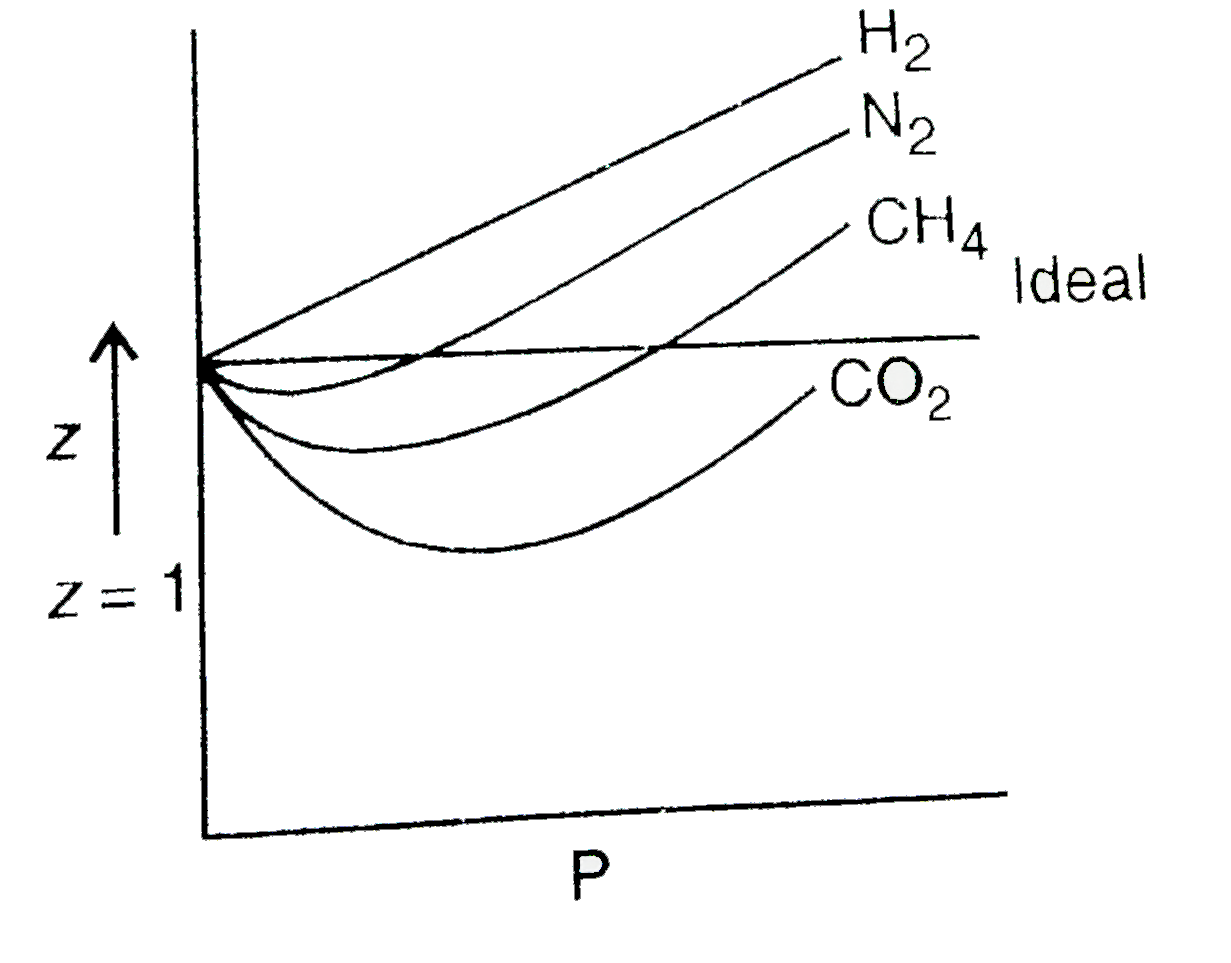

Answer the following questions on the basis of above write up :
Which of the following statements is correct gas A having molar mass 16 g and density 0.75 g/litre at 2 atmospheric pressure and `27^(@)C` temperature
View SolutionHomogeneous mixing and compressibiltiy both result from the fact that the molecules are far apart in gases. Mixting occurs because indicidual gaseous molecules have little interaction with their neighbours, assuming that no reaction taken place, the chemical identites is possible in gases because only about 0.1% of the volume of a typical gas is taken up by the molecules themselves under normal circumstances, the remaining 99.9% is empty space
Compressibility factor of a gas is given by
View SolutionHomogeneous mixing and compressibiltiy both result from the fact that the molecules are far apart in gases. Mixting occurs because indicidual gaseous molecules have little interaction with their neighbours, assuming that no reaction taken place, the chemical identites is possible in gases because only about 0.1% of the volume of a typical gas is taken up by the molecules themselves under normal circumstances, the remaining 99.9% is empty space
Assume molecules are spherical of radius `1 Å`, volume occupied by molecules in one mole of a gas at NTP is
View SolutionHomogeneous mixing and compressibiltiy both result from the fact that the molecules are far apart in gases. Mixting occurs because indicidual gaseous molecules have little interaction with their neighbours, assuming that no reaction taken place, the chemical identites is possible in gases because only about 0.1% of the volume of a typical gas is taken up by the molecules themselves under normal circumstances, the remaining 99.9% is empty space
For `H_(2)` and `He, force of attraction is negligible, hence, compressibility factor is
View Solution
Linked Comprhension type MCQs questions and complete solutions for chapter STATE OF MATTER (GASEOUS AND LIQUID STATE) of S DINESH & CO CHEMISTRY (HINGLISH) of Class 11